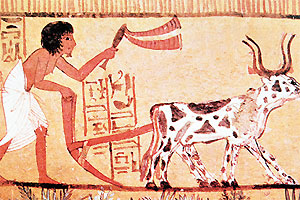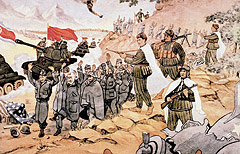Researchers disagree on the origin of the Egyptians. Some believe they had semitic roots (descendants of Sem, son of Noah, or of the peoples that settled in the Near East long ago). Others say they come from Africa, from the countries in the South and Ethiopia. Their physical appearance was similar to modern Egyptian fellahs or peasants. The people lived in square, low, mud brick houses with flat roofs. These houses were cool, as the windows were small, and did not allow too much sunlight in.
As for food, their diet was based on barley and wheat. Besides this, they ate vegetables such as onions, lentils, lettuce and such fruits as dates, figs and watermelons. At Banquets there was beef, duck, gazelle among other meats. Egyptians drank wine and beer. The latter was made from crushed barley bread.
Social classes
At the top of Egyptian society was the Pharaoh, who held absolute power over the lands and the people within his domains. He was worshiped as the son of the Sun and lived in a palace, surrounded by officers, innumerable servants and scribes.
The Priests were a powerful class. They presided over religious worship, and administrated the gods’ possessions; they were wise men and soothsayers and were feared and respected.
There was also the class of the Warriors that lived in the lands the Pharaoh conceded them. They had to answer all calls to arms. The army was an infantry forced composed of two bodies: one armed with a spear and an axe and the other armed with a bow and a dagger. Later developments led to the use of a body chariots. The nobility did administrative tasks on behalf of the Pharaoh, such as the levying taxes.
The most cultivated class were the Scribes. They could read, write and possessed some knowledge of accounting. They were the Pharaoh’s main agents, and could be found everywhere.
Other classes were the Merchants, who traveled throughout the country selling a variety of articles such as jewels and incense, the Artisans (carpenters, silver and goldsmiths, cabinetmakers and embalmers) and finally the Peasants, a caste to which the great majority of Egyptians belonged. There were also the Slaves, who were foreigners or prisoners of war.
A religious people
According to Herodotus, «the Egyptians are the most religious of men«. They created three categories for worship: of the local gods, of the main gods and of the dead.
Each province or nome had its own gods. Ptah was worshiped in Memphis, Ra in Heliopolis, Amon in Thebes, Thoth in Hermopolis, Osiris in Abydos. This was maintained even after unification. These gods were eternal and more perfect and powerful than men, although they also had to eat, drink and wear clothes.
They were frequently depicted in the bodies of animals, such as the sacred ox Apis that sheltered Ptah, or in bodies of men with the head of a beast.
The main or great gods were different versions of the Sun. The most important were: Horus, the rising sun, who vanquished Set, the god of darkness; Osiris, the setting sun, husband of Isis (the Moon), god of the dead ( the same as Thoth and Anubis); Ra, the sun in all its splendor and father of the Pharaohs. Temples were built and offerings were made for these and other lesser gods to ask them for favours and gifts.
The cult of the dead was related to the Egyptian belief that there was an intangible body, the soul, that fled when people drew their last breath and remained alive as long as the body did not decompose. This explains the importance of preserving the body, which led to the techniques of mummification, and added to the construction of tombs or funerary rooms with provisions and clothing for the afterlife.
The world’s richest country
Egypt’s economy was based on agriculture. The Nile’s annual floods provided the nutrients which helped grow many different crops. Throughout a large part of its history, this country was considered the richest in the known world. Crop surpluses were bartered for luxurious articles obtained in their trips down the Nile and around the Mediterranean sea, where they traded with other nations and regions like Libya, Palestine, Syria, Cyprus and Crete.








 Termina la Guerra de Corea
Termina la Guerra de Corea